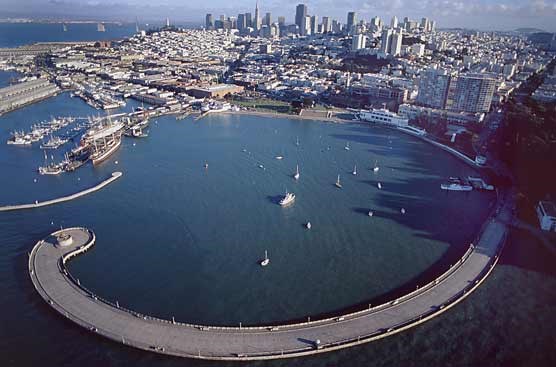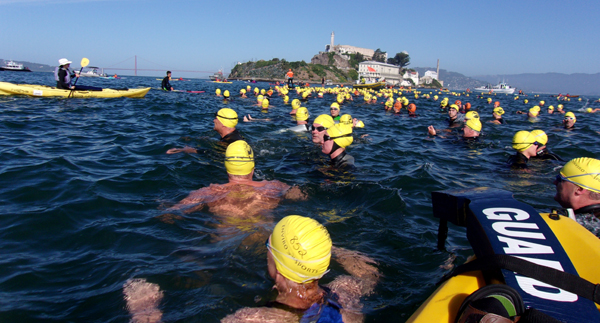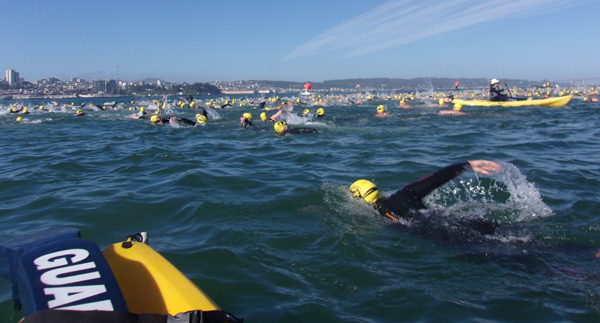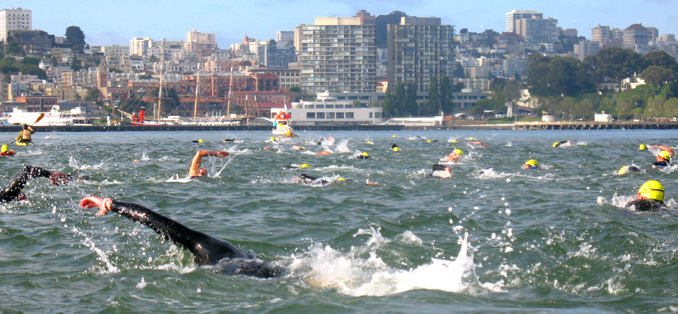The ‘Alcatraz Sharkfest’ a little less than 2 mile swim (or 1 1/2 miles if you swim accurately)
from Alcatraz to San Francisco and the ‘Escape From The Rock’ Triathlon
are great volunteer opportunities
– for lifeguards to get experience,
– for swimmers to get an up-close look at the race and consider trying swimming it
– for experienced kayakers to get a free San Francisco bay kayaking morning.
They need people (lifeguards or not) in kayaks to help the off-course or cold swimmers
and the race provides the kayaks and gear for free to volunteers.
They also need volunteers for other on-land, no kayaking experience needed, jobs, so swimmers considering trying this race can see what happens in person.

RETHINK volunteering for kayaking if you do not have sufficient experience and strength to paddle 4 to 5 miles, some of it against a current or in swells. When we have Outdoor Club kayaking events we stay in small groups and watch out for each other. This will not be the case during this race. You may be some distance from other volunteers. Volunteers will be watching out for swimmers, not for each other. If you fall out of your kayak you might have to get back in by yourself. (Yes, this has happened. One girl in 2000 fell out on the way to Alcatraz and on the way back. In 2002 one guy took over 12 tries to get back in his kayak when he fell out. He kept trying to get back on top, and kept falling over to the other side. Our lips are sealed as to their identities.)
The south tower of the Golden Gate bridge to Sausalito swim we volunteered at most recently were Sun, July 22, 2018 and Saturday, Sept. 9, 2023. Most of this page is about the Alcatraz swims, but a lot applies to the Golden Gate swim. You can find an aerial photo of the race route under the Golden Gate bridge at: https://raceroster.com/events/2024/80149/2024-golden-gate-sharkfest-swim Photos from our Golden Gate swim volunteering are at:
Golden Gate Sharkfest July 22, 2018
All upcoming races are usually linked to from (and you can find a link to volunteer at: http://sharkfestswim.com/
2024:
Sunday, June 16, 2024 – Escape from Alcatraz Sharkfest 1.5 miles
Sunday, June 30, 2024 Golden Gate Sharkfest 1.6 miles
(no date for 2024 the last time I checked) Alcatraz “Escape from the Rock™ Duathlon – 1.5 Mile Swim, 7 Mile Run. The course combines the original swim from Alcatraz with a 7 Mile Run to Fort Point and back to Aquatic Park.
(again, find details at: http://sharkfestswim.com/ )
Volunteers need to be at most of these 5:45 a.m. or earlier.
(Previous kayaking experience needed, for example, perhaps starting with one of the Outdoor Club kayak lesson and paddling trips. I do recommend to my swim students that if they want to try one of these swims eventually, they could volunteer at one first.
BUT please note that volunteering at, or swimming any race, will not be an official De Anza College or De Anza College Outdoor Club event and it can’t get you a better grade in any class I teach.
You can help as a volunteer on shore, but they need experienced kayakers, to help out in kayaks on the water as well.
The kayakers have a better view than the swimmers of the city sights. In one direction is the Golden Gate Bridge, in another the Bay Bridge, and we’ve spotted the Palace of Fine Arts along the city skyline. In 2000 and 2017 all this was in sunshine, in 2001 and 2002 it was cloudy with occasional swells that bounce kayaks around and that we couldn’t see swimmers over. The swimmers sometimes were swimming uphill up the face of some swells then riding them back down the other side.
The races are named the Sharkfest, but we have never seen any sharks. Occasionally we see a few seals swimming and diving at the outside edge of the swimmers. Or at the edge, a seal popping up and loooooooking at the migration of these strange marine mammals.
During the swim, the shipping channel between Alcatraz and S.F. is closed to shipping and there is a Coast Guard boat out on the water with us as well.
Below an aerial photo (courtesy of the NPS) of Aquatic Park, San Francisco, where the athletes and volunteers meet before the race. It is also the finish for the race.
We usually have the time for a group photo on the beach before we set out.
The kayak escorts paddle themselves out, going towards the east side of Alcatraz island (the right side as you see it paddling out).

In many of the pictures from previous years below you will see the lifeguards in place where the athletes jump off the ferries. More recently the race decided to have them set back farther (in a start line) so there is no risk of being bumped by the ferries as they move in.

The swimmers ride to Alcatraz on two ferries which approach from the far side of and around the back of Alcatraz island.

The ferries might line up side by side or in a row. They might stop and then start up again and adjust their position. One year guards who were in place early between the two ferries were thrown from their kayak when the wash of the restarting, readjusting ferries hit them from both sides. The athletes who saw this were yelling, “look, the lifeguards are in the water.” The lifeguards got back in their kayak in record time with much composure. In more recent years, the race decided to not allow lifeguards or any paddlers near the ferries, since the ferries adjust their positions a lot.
Below, kayakers applaud and cheer the arrival of the ferries:
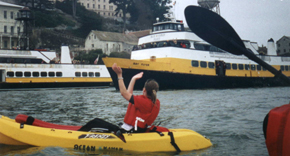
Some of the kayakers (often lifeguards) form a start line near the tip of Alcatraz Island. The rest of the paddlers form two sides of a U to help keep the athletes on course.
The athletes jump off the ferries:
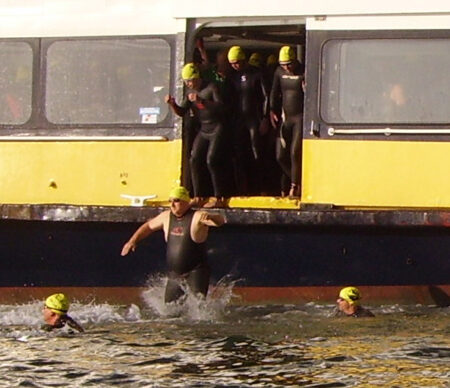
Below: first swimmer in 2006 off one of the ferries, (American Red Cross Lifeguard Instructor and Lifeguard Instructor Trainer) Ken Mignosa, with his destination in the background and the race boat with huge red buoys as a target. Ken started his swim with butterfly. He said he was literally swum over by others more than once during the race.
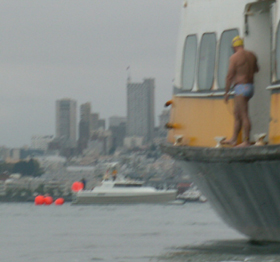
The swimmers jump off the ferries and swim towards the start line of kayakers, then tread water, before the start.
The start line is often not quite straight.
(As I took these photos from my seat in my kayak, many of the athletes treading water and waiting for the start were turning towards us and thanking us for being there.)
In this next photo you can see the boat with big red buoys the swimmers will follow to near the entrance to Aquatic park where their finish is.
Those of us with radios can hear the countdown and start yelling out ten, nine, eight, seven . . . and cheers come up from the athletes, then the race is on:
The direct route for the swim would be 1 1/2 miles, but the actual longer swim (a little less than two miles) is a “sloppy, backwards C-shaped course” due to the tides,
at first in a crowd:

and later more spread out:

In this photo below you can see the lead boat with the huge red buoys for lead swimmers to follow, and beyond it, the entrance to Aquatic Park, the Maritime Museum (large, white building), and the Balclutha sailing ship:
In the photo above you will notice that many of the swimmers lift their arms higher out of the water on their freestyle recovery than you have been taught to. This is because they are swimming in choppy water. If your swim coach/swim instructor allows it, you could do laps with your arms extra high out of the water to develop the strength necessary.
The kayakers are pre-assigned to go to one side of the mass of swimmers and keep an eye on them (more below about kayakers duties).
The next photo from 2017 is courtesy of the race. You can see the row of kayakers on each side of the swimmers, trying to keep them on course (and help those in trouble and turn around those who get disoriented and start swimming to Oakland or back to Alcatraz):
Near the end of the swim time (usual cutoff of 75 minutes) the current changes and the athletes can’t swim fast enough to get to the finish, so some are given a lift on a Zodiac or boat to the entrance to Aquatic Park (the swim finish is on the beach there) where they can complete the swim.
_______________________________________________
A letter to participants stressed that it is not a race for novices, and said
“if your time for a mile in the pool is slower than 40 minutes, we do not recommend you attempt this swim.”
AGE GROUPS: “Male and Female: 5-6, 7-8, 9-10, 11-12, 13-14, 15-17, 18-24, 25-29, 30-34, 35-39, 40-44, 45-49, 50-54, 55-59, 60-64, 65-69, 70-74, 75-79, 80-84, 85-89, 90-94, 95-100!”
Many swimmers take 39-42 minutes, some over an hour, some can’t finish within the 75 minutes allowed before the tide changes and you can’t swim to SF.
Some of the people in their sixties beat people in their teens.
A few in their seventies beat people in their twenties.
People from all over the U.S. and many other countries swim this race. In 2017 the list of cities people came from included almost every city/town in California as well as London, Perth, Sydney, North Vancouver, St Louis, Fort Worth, Boston, Tacoma, Tempe, Fort Collins, Phoenix, Woodstock, Holland, Batavia, Denver, Mesa, New York, Salt Lake City, Huston, Scottsdale, Albuquerque, Bend, Las Vegas, Nashville, Raleigh, New Orleans, Kalamazoo, Seattle, Quebec City, Lake Waukomis, Naperville, Boulder, Philadelphia, Baltimore, Annapolis, Cedar City, Venice, Val-d Or, Colorado Springs, Calgary and Winnepeg.
_______________________________________________
I am giving some information about what gear to bring or wear for possible volunteer kayaking, but you must read and follow any information mailed to you by the event sponsors. Most years they have many loaner wetsuits for volunteers in kayaks, but you’d be more sure of one if you borrowed one in advance, and your own will fit better. They DO NOT recommend being out in a kayak without a wetsuit!
A hat with a brim that will stay on in wind is a good idea, as well as croakies or other eyewear retainers for your sunglasses. We would like to note that the water is quite cold, (60-62 degrees, with some cold spots) and a spare swim cap on your person could be put on if you get wet and cold. We always recommend a whistle, a bottle of water and a good breakfast to start your day. (Put the whistle cord around the armpit area of your lifejacket, not around your neck.) CPR pocket mask/gloves, for those who know how to use them.
Fleece to put on after if you are cold and a change of clothes for after is also a good idea, and a towel to use after you rinse off the bay water, possibly using warm water you brought in gallon bottles in your car (no warm showers at the site, but there is usually at least a cold water hose).
Leave/hide valuables in the car as there is no safe place to leave gear at the site.
You may have to pay for parking, and you may wish you had a camera (waterproof? with a flotation device should you drop it overboard).
The race has said: “SwiMP3 devices nor any other music apparatus are NOT allowed during any of our swim events. All swimmers need to be paying attention in case of any notifications needed to be given by on-water safety personnel,” and such devices should not be used by kayaking volunteers, even for the paddle out to Alcatraz.
Don’t leave gear out unattended – stuff has been stolen previously when people left it sitting in/on a kayak on the beach and went sightseeing. We need to have people take turns watching gear.
Do not volunteer to help in a kayak unless you completely intend to be there. The race director has to pay to get you a kayak, and it’s not acceptable to say you’ll be there, then sleep in or change your plans at the last minute because a friend came over, etc. Often the race turns away volunteer kayakers when all the kayaks are spoken for. (One year someone late for volunteer check-in grabbed one of the kayaks we had set aside and paddled off, leaving one of our volunteers without a kayak, so (again), we need to have people assigned to watch gear.)
Fill your gas tank, pack your gear and put the breakfast snacks, pot-luck lunch food and ice into an ice chest the evening before. Set three alarm clocks (what, for before 4 a.m. for an 8:45 a.m. race start??) in different parts of the bedroom, or better yet, stay over at another volunteer’s house you are carpooling with so you can get each other up!
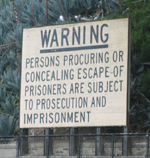
_______________________________________________
Athletes are told (this is from more than one year of instructions) :
“Will there be restrooms or changing facilities on race day morning?
Port-a-potties will be set up at the end of the promenade near the Dolphin Rowing Club (if you’re walking with the grandstands on your right, continue down the path and you’ll find them). There will not be private changing facilities available…
· The start line will be marked by a row of kayakers. Swim up to the start line, but please don’t hang on kayaks or crowd around them. You may swim around to warm up behind the start line, but keep in mind, everything starts rather quickly — 6 to 8 minutes after we start disembarkation. . .
WHAT TO EXPECT DURING THE SWIM
SUPPORT
Lead kayaks will direct the front swimmers along the correct course. Additional kayaks and boats will corral the remainder of the field. A designated lead boat will have a large orange buoy aboard to assist you with sighting. There will be no buoys in the bay to guide you; rather, you will use the lead boat and escort boats as your guides. If you are swimming astray, you will be advised to change course. You must obey the instructions of all escort personnel. Non-compliance with this rule will result in automatic disqualification.
TIDES
(from one year) This swim has been timed to take advantage of the currents, with the start timed to catch the tail end of the flood tide. As you begin your swim, the tides will be slack. As you progress towards Aquatic Park, a slight ebb tide kicks in (sweeping you right, or west, toward the Golden Gate Bridge). There is a stronger ebb channel along the entrance to Aquatic Park. Kayakers will direct swimmers about 200 yards east of the entrance to Aquatic Park to take advantage of the strong ebb current along the waterfront. Don’t be fooled – Even if the water surface appears calm, the tides are always present. Swimmers who aim directly for the entrance will be swept toward the Golden Gate. There will be support boats and kayaks stationed west of the entrance to Aquatic Park to collect any swimmers who miss it.
(and from another year) When the ferry drops you off on the east side of the island, and as you round the south end of the island when you start your swim, Aquatic Park (your target) is straight ahead. You will be given instructions race day morning on which buildings to spot off of during the swim. These instructions are based on a test swim conducted the day before during similar tidal conditions. Mind these instructions.
If you aim directly for Aquatic Park, the tide will sweep you west past the entrance and a boat will have to pick you up. If you aim too far left, the worst that can happen is that you may have swum slightly farther (with the current behind you) until you reach the entrance. If you aim too far right, you’ll end up west of the entrance, swimming in place against an unbeatable current and trying to get back.
PACE
Our objective is to have everyone successfully complete the swim from Alcatraz to San Francisco, but if your pace puts you too far behind to guarantee your safe completion, a boat will pick you up. You may be moved to a more favorable location, where the tide will work to your advantage and you may complete the swim; however, swim officials have the authority to make an objective assessment of your progress with respect to the current tide conditions and may decide to drop you off inside Aquatic Park. If an official tells you to get into a boat, it is expressly for your safety, and you must comply or you will be disqualified.
MILD PANIC
If you find that when you jump in the water or start to swim that your heart begins to beat rapidly and your breathing feels out of control, this is perfectly normal. It’s just the adrenaline rush of raceday paired with the shock of the cold bay water. Use your own judgment on whether to continue, especially if you have any medical conditions, but most people find that if they continue to swim, they warm up, get their breathing back under control and are able to get back into a groove and finish the swim. You may backstroke, or swim with your head out of the water until you’re comfortable to swim again.
GETTING ASSISTANCE
If you feel that you cannot complete the swim or you need the assistance of a kayaker, stay put and put one arm straight up in the air. A kayaker will come to you and discuss your options. It is perfectly legal to grab the nose of a kayak and wait out a cramp, get your breathing under control, etc. Don’t hesitate to take the measures you need to finish your swim. (Note: If you need to grab onto a kayak, grab onto the nose; NEVER grab a kayak from the side, as you may tip it over).
A smart athlete will know when it’s not his or her day. You’ll always be welcome to come back and try again. There’s no shame in taking a rain check on this event.”
and athletes were given this advice about a Golden Gate swim:
“I’m worried about the swim.
The Golden Gate swim course may have a notorious reputation, but we can assure you we’ve safely escorted swimmers along this course 6 times in years past. The biggest variable is the tides. Luckily, our race director, Dave Horning, has swum the course over 6 times and knows the San Francisco Bay tides well. We specifically plan the date of the swim in accordance with the tides.
Once the race starts by the South Tower of the Golden Gate Bridge, You will aim for the North Tower of the bridge. The tides will naturally carry you under the bridge as you swim North. There will be a lead boat to follow across the “gate” and to the swim finish. You will be given instructions race day morning on which sights to spot off of during the swim. These instructions are based on a test swim conducted the day before during similar tidal conditions. Mind these instructions.
Use your common sense and practical judgment and you’ll be fine!
Any other advice on the swim?
Swim gloves and booties are discouraged on this swim unless you have trained using them and are extremely comfortable swimming in them. They can sometimes fill with water and make it more difficult to swim.
Neoprene swim hoods are allowed. Please wear the swim cap given to you over your swim hood. Another option is to bring an extra swim cap and wear it under your event swim cap which can help keep your head warmer.
Hold on to your goggles as you jump from the ferry as they can sometimes easily pop off as you hit the water.
Swim away from the boat immediately after entering the water to make way for the next participants. The faster everyone disembarks, the sooner the race can start.
The start line will be marked by a row of kayakers. Swim up to the start line, but please don’t hang on kayaks or crowd around them. You may swim around to warm up behind the start line, but keep in mind, everything starts rather quickly — 6 to 8 minutes after we start disembarkation. The race starts at the sound of the ferry’s horn.
What if I panic during the swim?
If you find when you start to swim that your heart is beating rapidly and your breathing feels out of control, this is perfectly normal. It’s just the adrenaline rush of race day paired with the shock of the cold bay water. Use your own judgment on whether to continue, especially if you have any medical conditions, but most people find that if they continue to swim, they warm up, get their breathing back under control and are able to get back into a groove and finish the swim. You may backstroke, or swim with your head out of the water until your comfortable to swim freestyle again.
If you feel that you cannot complete the swim or you need the assistance of a kayaker, stay put and put one arm straight up in the air. A kayaker will come to you and discuss your options. It is perfectly legal to grab the nose of a kayak and wait out a cramp, get your breathing under control, etc. Don’t hesitate to take the measures you need to finish your swim.
A smart athlete will know when it’s not their day. You’ll always be welcome to come back and try again. There’s no shame in taking a rain check on this event.”
The race director will send out instructions to volunteers in advance of the race about whether to blow a whistle blast to alert help when you have a swimmer who needs help, but usually paddlers at least raise their paddles (and sometimes wave them – follow the race director’s instructions) to signify that they have a swimmer who needs a ride in…
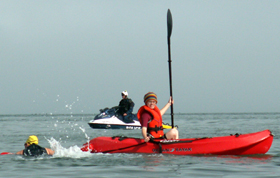
and the SFPD or another support craft picks up the swimmer…
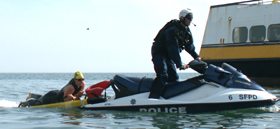
and more advice from previous years given to the athletes: “WARNING SIGNS
If you start to get cold and can’t think straight, you are experiencing mild hypothermia and should make the choice to end your swim. Full hypothermia may result in death. Don’t be ashamed or hesitate to call it quits early. If you decide it’s just not your day, stay put and raise your hand. Yell to get the attention of an escort, and you will be picked up.
VERY IMPORTANT!
If you drop out and do not go through the swim finish chute, be sure to check-in with an official at the race finish to notify us that you are on the beach. We don’t want to have to launch a search and rescue unless someone is truly missing in the water.
_______________________________________________
Swimming with a balloon tied to you can do many things:
– make it easier for the assisting kayakers to keep you in sight
– make it easier for your spouse/future spouse who is also swimming to keep you in sight
– create a more festive atmosphere
– create drag and slow you down, or interfere with your arm stroke
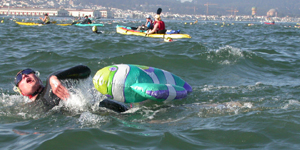
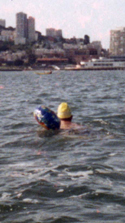
_______________________________________________
Notes for paddlers: from the race directors from previous years by way of example.
Please carefully read what they send you for the race you volunteer at.
The primary responsibility of our water support crew is to be the first line of safety during the swim.
§ It is critical that each and every kayaker constantly scans the water in order to spot swimmers in distress.
(We have seen some volunteer kayakers who get over-confident about the abilities of swimmers and hang out talking to other kayakers during the race. A swimmer can get into big trouble very suddenly and will need to be able to wave at the nearest kayaker and get eye contact and will need a kayaker coming for them quickly.)
§ At the first sign that a swimmer needs your help, paddle over to the swimmer – being careful to avoid other swimmers. Don’t be afraid to block swimmers heading toward you; if a swimmer is in distress, approaching swimmers can swim around you.
§ Approach the swimmer carefully, advising the swimmer to hold on to the bow of your boat. DON’T let a swimmer grab the side of your boat, causing you to capsize. Back away if the swimmer tries to grab any part of your boat except the bow.
§ If it is apparent that the swimmer requires immediate medical attention, raise your paddle to the vertical position and blow your whistle to summon the nearest support boat.
§ Swimmers who are cramping or need to catch their breath may hold the nose of your boat and wait until they are ready to resume the swim without penalty or disqualification. Sometimes all these swimmers need is a nod of encouragement. Let them know that their anxiety is perfectly normal and to take it slow, get into a groove and relax! After all, this is supposed to be fun!
§ To turn a swimmer who strays off course, move ahead and well in front of the swimmer and bang your boat with your hand or paddle. This usually makes the swimmer raise his/her head and look at the kayaker; point out the direction the swimmer should go.
(The swimmers should aim for the boat with the big red bouys and aim not for the entrance to Aquatic Park, but off to the left about 200 yards, where the current will back them up. If they “aim too far to the right” they will “end up west of the entrance, swimming in place against an unbeatable current and trying to get back.” If kayakers on the right side of the mass of swimmers (right side as you face the direction they swim) go too far to the right, the swimmers are sighting on them and can end up too far away from the left side of the entrance to Aquatic park.)
§ Some swimmers will want to bail out immediately after starting because they aren’t used to swimming in open water. This first portion is often the busiest for the kayakers. Again, if a swimmer does not want to continue the swim for any reason, raise your paddle to the vertical position and blow your whistle to summon the nearest support boat.
§ As the last of the swimmers is finishing, kayakers should find the trailing swimmers and follow them to the beach. Be sure no trailing swimmer is left behind the kayakers.”
_______________________________________________
________________________________________
One year a Sergeant with the SF Police Department Marine Unit added additional protocols. (Again, please carefully read what they send you for the race you volunteer at. The race director will give you info about if you will use a whistle, or how many whistle blasts for what kind of help needed, either in advance of the race by email and/or on race morning.)
Safety issue – if you observe a swimmer in distress:
-Give 5 short blasts on your whistle (if you don’t have your own whistle, one will be issued to you on race day morning)
-Wave your paddle in the air. ALL OTHER PADDLES MUST BE LOWERED so it is obvious who has a swimmer in distress.
-Kayakers with radios will cease all radio communication until the distressed swimmer has been located and the all-clear has been issued.
Here is one more important thing to know . . .the difference between a swimmer in distress and one that just wants to end his swim and would like a ride back to the beach.
Any of these things might indicate a swimmer in distress: Someone panicking and grabbing the side of your kayak or someone with a serious medical issue ((examples: chest pain, injured after being kicked by another swimmer, actually breathed in water on the jump from the ferry, a debilitating muscle cramp, someone obviously hypothermic, or someone with asthma that might need their inhaler). These people need medical attention IMMEDIATELY and this is when you give 5 whistle blasts and wave your paddle in the air.
There will be other swimmers who may just be unhappy, don’t have their breathing under control, threw up their breakfast, have a mild leg cramp, may be cold, or just want quit and get a ride back to the beach. For these swimmers, you will give one blast on your whistle and hold your paddle vertical so one of the rescue craft can come pick up the swimmer.
______________________________________
_______________________________________________
My notes for lifeguards and other volunteer paddlers. It is impossible to actually “guard” this many swimmers, but here are some tips:
Competitors are allowed to use any stroke.
Expect the possibility of:
— As they jump in from the ferries, we need to be prepared for gasp reflex (if someone breathes in water as they hit the cold water).
— A few just suddenly feel too tired/cold and want to quit. You might be able to convince them to give it a try and swim for awhile.
below: lifeguard Minh Nguyen assists a swimmer at the very beginning of the race as a race boat pulls nearby to pick up the swimmer
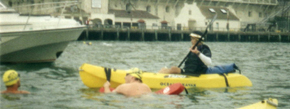
— At the start, the extremely slim possibility of someone jumping on top of someone else as they jump into the water from the ferry. (The race has ‘bouncers’ at each ferry exit to control the athletes and we have never seen anything close to this happen.)
— Some will be accidentally kicked or elbowed or they will turn to breathe and be unable to because of choppy water.
— Some will have other swimmers accidentally swim over the top of them.
— Athletes may have muscle cramps, mild or so totally debilitating that an athlete can’t even hold a kayak bow or rescue tube.
—Some athletes will want so much to finish, they’ll keep trying despite cramps longer than they should, and are in big trouble by the time they swim aside from the pack and are first noticed–or–by the time they actually wave or speak up for help.
—Panic leading to one competitor grabbing another and a guard rescuing both at once. (In one case at a Danskin Almaden Lake race the woman who was grabbed tightly from behind by a panicking swimmer wasn’t upset at almost being drowned, she was mad that her time was being slowed!).
–Ate the wrong breakfast (possibly combined with nerves and a little ocean water) and needs to throw up, potentially while resting at your kayak. (At a Bud Light triathlon many years ago, a lifeguard we all knew who was competing in the race threw up three times at/on three different guard’s rescue boards.) If they think about it, most will realize they feel much better after vomiting, and can finish the race. You could suggest to them that they probably feel better. You could position your boat where it will keep other swimmers from swimming into the vomit and use your paddle to stir it around and dissipate it before you head on.
–They might have been kicked while swimming in a tight group of swimmers; most likely near the start. The accidental kicking can possibly dislocate someone’s shoulder (rare, but it happened to a pro in the first wave of a Bud Light tri).
—About 90% wear wetsuits and can still get hypothermic (extremely cold). Some who are too too hypothermic or have other problems (need their inhaler, for example) are given a ride all they way to the finish, and if needed, helped to the medical staff in the ambulance waiting on shore.
–Breathed or swallowed a little water (a little seems like a lot). May only need a little help, or potentially a lot of encouragement to go on.
When I refer to a victim who may have “breathed a little water,” I want to be sure you all understand that I mean someone who choked on a little water, not actually aspirated any. I talked to a Race Doctor at a Danskin tri about this, and she said “think back to your own experiences swallowing water”… aspirating is “more spasmodic, a little more panicky, and a little more out of control.”
If an athlete actually exhibited active drowning behavior, and/or you have reason to believe they did aspirate (breathe in) water, they need to be seen by the doctor even though they may be embarrassed. Talk to them about it. If they just want to leave the swim and/or rest alone, or go home, don’t let them if you think they aspirated water. Be sure the boat that picks them up knows that they need to be seen by an EMT on shore.
If they refuse help even though they admitted they breathed in water, or you are sure yourself they did, at least try to get their number if they swim off and report the number to the race offcials.
Remember, as noted by the United States Lifesaving Association, “It has been estimated that of all patients in near-drowning incidents, 5% will develop complications due to water aspiration and 25% of those will result in death.”
Many athletes will stay head down and just swim freestyle determinedly. Some will use mostly breastroke, sidestroke or even elementary backstroke. (From a distance, elementary backstroke with an out-of-the-water arm stroke recovery looks very much like a classic active drowning victim!)
Some will pop up their heads--this could mean
they are sighting ahead,
or couldn’t get a breath to the side,
just got bumped or kicked,
just kicked someone and are apologizing — or — are looking for assistance.
At A Golden Gate Sharkfest swim, where people swim the length of the Golden Gate bridge – right along under the bridge, we approached an athlete who was stopped and treading water to ask if he was okay. He said “I’m looking at the scenery!!”
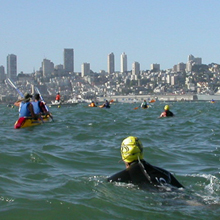
There is the possibility that you won’t notice a person in a crowd who needs help and is not moving or not popping up their head, but will notice people swimming behind them reacting to them.
They each wear a Velcro ankle strap timing chip so they can get their time for the swim only race or for each section of the tri as they run up on the beach and step on a pad. Some might stop near you and want to hold on to your boat just long enough to adjust their ankle velcro timing chip.
Others might ask you to take their photo with the camera they have.
The last swimmers may want you to stop frequently so they can rest, then take off again. If they want to talk, try to keep up a positive conversation. Some paddlers end up coaching 4 or 5 as they take periodic rest stops at/near the kayak. (More likely at the Sharkfest swim than at the Tri.) Be positive to everyone, but not to the point of insincerity or inappropriateness.
Yes, it would be great to pick up floating trash as you go.
_______________________________________________
How fast? Best times are around 1/2 hour.
One year the fastest was a 25 year old male with a wetsuit 0:27:06.1,
fastest female with a wetsuit was 25 years old, 0:30:13.0.
Among the non-wetsuit swimmers, fastest was a 49 year old male 0:31:17.0 and a 39 year old female 0:32:04.9
In 2017 many swimmers took 39-42 minutes. The fastest swimmer in the non-wetsuit category (yes, in 58-62° F temperature water, wearing no wetsuit) was a 19 year old male at: 30:24.7.and a 15 year old female at 32.11. In the wearing a wetsuit category an 18 year old male had a time of 29:15.2 and a 37 year old female at 31.03.
Some swimmers in their sixties beat people in their teens.
A few in their seventies beat people in their twenties.
_______________________________________________
An athlete wrote after one race:
Dear Envirosports,
I just completed the Alcatraz swim yesterday and I wanted to compliment you on the organization, the experience, and if you had anything to do with the weather, the sunshine as well. This was my first time swimming from Alcatraz and I was a little nervous. (O.K. I couldn’t sleep the night before). But what really impressed me was how SAFE I felt. Once in the water, the kayakers really kept an eye on everyone and while I was swimming, I could always spot kayakers nearby and they kept us all going in the right direction. Feeling that “watched over” took away all of my anxiety and I could swim and really enjoy the experience. I had a wonderful, fun time and I can’t wait to do it again. Thank you for your attention to detail and for taking such good care of your swimmers. Please thank all the kayakers as well.
Mary Louise Schmalz
_______________________________________________
If you use Google maps to find “Aquatic Park Pier, San Francisco, CA”, you can go to “earth” view (rather than “map”) scroll out and see Alcatraz (the swim starts on the east side) , the entrance to Aquatic Park, and the beach at the south end of Aquatic Park where the swim finishes.
Below, a couple of years views of the beach finish from part way across Aquatic Park:
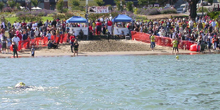
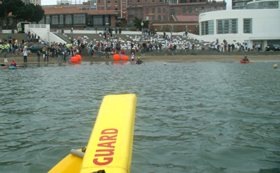
_______________________________________________
You won’t be allowed on Alcatraz Island during this race, but can see a 360 degree view at
_______________________________________________
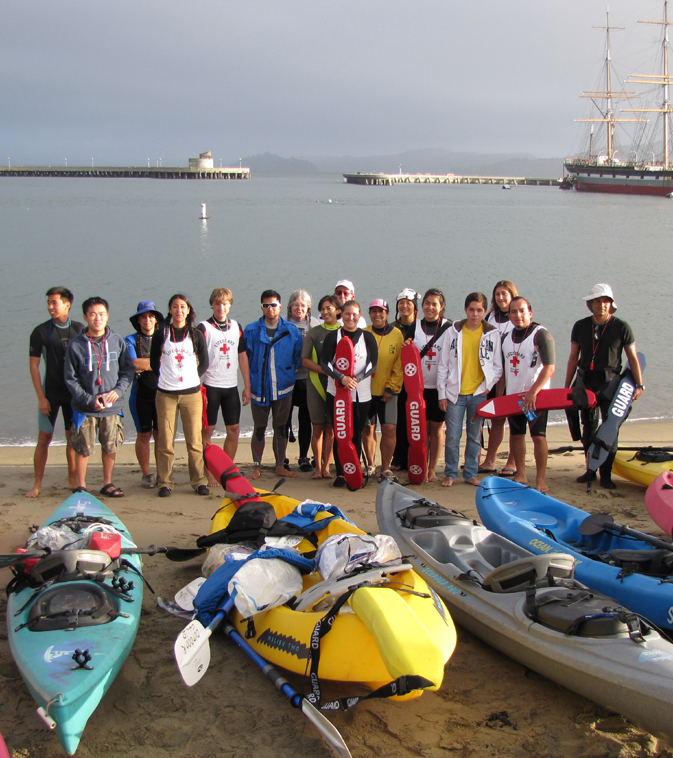
Group photos of De Anza volunteers at the race are at:
Alcatraz group photos
Plus, see volunteering at the:
Golden Gate Sharkfest July 22, 2018
2017 Escape from Alcatraz Sharkfest swim,
lifeguards at the Escape from Alcatraz Alcatri 2010,
guarding the Sharkfest and Alcatri 2007,
guarding the 2006 Alcatri triathlon,
Sharkfest 2004 lifeguarding,
and Sharkfest 2003 lifeguarding have more pictures.
Thinking about swimming this race? Sign up in advance; the race size is limited. It fills two to four or even more months in advance.
Volunteers and swimmers should go to: http://www.envirosports.com and click on the race you are interested in. From there you can find advice to swimmers and a race map.
see also: tips for guarding kids’ triathlons and open water swims https://marydonahue.org/tips-for-guarding-open-water-swims
U.S. Masters Swimming has tips for staying safe in open water https://www.usms.org/fitness-and-training/articles-and-videos/articles/how-to-stay-safe-in-the-open-water
Read about the history of Alcatraz and public access to the park:
https://www.nps.gov/alca/index.htm
Details about Outdoor Club events
(again, volunteering at this race is not an official club or college event)
are at:
Outdoor Club Coming Attractions
Answers to most questions about how the De Anza Outdoor Club works are at: Outdoor Club Basic Info The main rules common to most of our trips, including who is eligible to go, are at: Outdoor Club trip rules .
